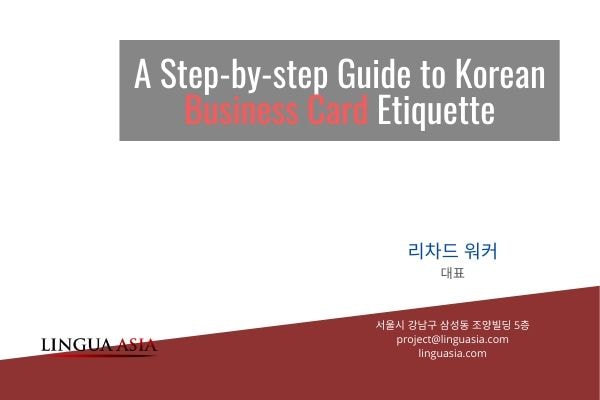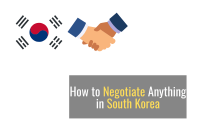Not sure how to exchange business cards with Koreans?
Whether in their country or abroad in the U.S. or U.K., here’s what you need to know about Korean business card etiquette.

Quick Summary
- Start with a slight bow and a handshake with both hands.
- When presenting your business card, turn it, so the receiver can read your name easily.
- Receive someone’s card with both hands.
Background info
There are a few rules that you should keep in mind during the process.
A person’s company and job title are important in Korea.
Seniority and age also play a big role in your interactions.
As you can guess, a business card is a serious matter here. It basically represents one’s standing in society. You must treat business cards with reverence if you wish to build a productive relationship.
Designing and printing business cards is a good trade to get into, since there’s always demand. It’s like they say, “sell pickaxes instead of mining gold”.
Taking light of someone’s business card is like making fun of someone’s face in western countries. It won’t win you any favors.
Even if you have the person’s contact info, and have conversed with them at length, you must exchange cards when you meet them for the first time.
There’s a stratified party A and party B relationship to Korean business culture. This known as 갑을관계 (Gahb uhl gwangye). If you are an 을, then you will be deferring to the 갑.
There’s even an expression that describes when someone abuses their 갑 position. This is known as 갑질 (gahbjil, or actions of a gahb).
Even if you are considered a 갑, it’s good form to not overplay that hand as your counterpart will not appreciate it.
Do’s
- Like with business gifts, it’s basic etiquette to give out your business card when receiving someone else’s. So it’s a good idea to have business cards ready at all times in public. Make sure to bring enough to important meetings or conferences.
- It’s common courtesy for the lower positioned or younger person to give their business card first to the other party. This is true if you’re dealing with a current or potential client. Also, when you visit another company, it’s better to present your business card first.
- When you’re with your boss or superior, it’s polite to give your business card after your boss does.
- It’s polite to exchange business cards while standing up.
- When you’re sitting, it’s important to get up, greet (say “annyeonghaseyo”), state your company name and your name, and present your business card with two hands.
- It’s best not to exchange business cards during meals or meetings. Before or after would be better.
- Writing on your own business card to update an email or phone number isn’t rude, but it looks unprofessional. It’s a lot better to just print new cards.
- Keep your business cards clean. It’s better not to give out old or wrinkled business cards.
Don’ts
- Never stack your business cards on the table like a deck of cards.
- Never play with someone’s business card.
- Never fold or stack someone else’s business card.
- Never throw your business card or deal it like a playing card.
- Never present your card with your left hand, even if you’re left handed as this is considered bad form.
- Never write on someone else’s business card unless you ask permission to add information. Or do it when they’re not around.

Step 1.
Get business cards made with Korean on one side and English on the other. By spending about 10 dollars, you can immediately make yourself more likeable to Koreans.
Step 2.
Buy a business card holder. Failing that, your wallet will do. Keep business cards in the card holder, but separate yours and others.
Step 3.
The dance begins the moment you meet.
Start with a slight bow and a handshake with both hands. Or simply touch your right elbow with your left hand underneath. Women might not shake hands, so only do so if they offer first. If they don’t, a bow will work.
Step 4.
There’s not much small talk at this point, so go straight for the card holder or wallet. This may seem awkward at first, but that’s only true if you think it is.
Step 5.
When presenting your business card, turn it, so the receiver can read your name easily. This is akin to handing someone a knife handle first.
Then hand it over with both hands and a slight bow.
More about business trips in Korea
Step 6.
When handing your business cards to several people, it’s advisable to give them out one by one, starting from the highest position to the lowest.
Step 7.
Receive someone’s card with both hands, and say the person’s name and title out loud with a “-nim” at the end as a sign of respect.
Take a closer look and ask immediately if you have questions about the person’s position or title.
It’s rude to receive a business card and put it away immediately in Korea.
Step 8.
Once you sit down with Koreans for a meeting after exchanging business cards, make sure to place their business card in front of you on your right side.
FAQ
Which language should business cards for Korea be in?
It’s a good idea to have your cards in Korean on one side and English on the other.
Did we miss anything?
Business cards are very important in Korea and so is the exchange of them.
Follow these steps and your relationships will start off on the right foot.
I had to learn business card etiquette on the job by observing other people.
If you do make a minor mistake, don’t worry. It won’t be viewed too harshly since you aren’t from Korea.
Let us know if you have any questions below!



